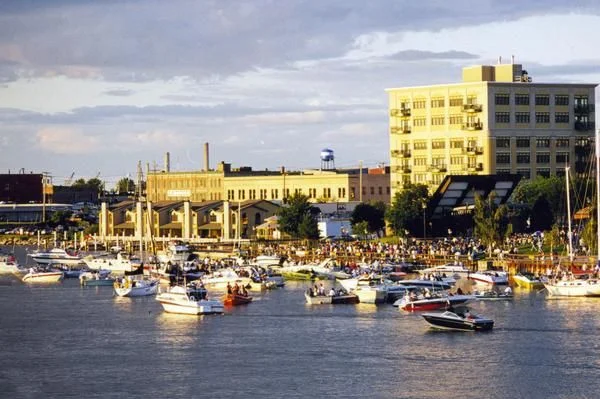I grew up in Essexville, a small working-class town on the border of Bay City, Michigan. As a young child in the 1980s, I remember a new shopping mall going up, lots of auto-oriented commercial strips being constructed on the developing suburban areas of the city and wondering, “Why isn’t all this development going downtown?” Thinking back, my observations of a declining Bay City were reasons why I chose to study planning and development. I wanted to make an impact and try and help restore my hometown.
Bay City has a long history dating back to settlement in the 1830s when the city's economic vitality developed first in lumber, and then manufacturing. Unfortunately, this mid-western manufacturing town has been struggling for decades. By the early 1990s, my hometown began marketing summer festivals by creating a tourism-based local economy. Slowly but surely, this strategy is beginning to have an effect today. But why do small towns have a much harder time at economic re-development than our large metro city centers? Let’s consider some ideas why this may be the case.
Bay City, MI is a small city of approximately 35,000 people. It was once a major manufacturing center for the region. Shipping and manufacturing are still prominent forces in the area, but nowhere near the city's previous capacity. (Source: Dunlop's Downtown)
Economic development, or “redevelopment”, basically boils down to maintaining and creatively redefining a downtown to expand its city’s tax base. Disinvestment and relocation of jobs prompts city residents to relocate within the region or another state all together – if they can afford to move. In Bay City's case, manufacturing jobs from the city were relocated someplace else.
Along with the creation of a hyper-consumer economy based around the American suburban lifestyle, cities have received a devastating one-two punch since the 1950s. N. David Milder, a nationally recognized economic revitalization consultant, wrote an article on the main supporting tenets of economic development widely understood by planners and developers. Small towns are like their large-city cousins in that both require a comprehensive approach toward redevelopment that strategically leverages their existing assets. [2]
What is difficult for small towns then can be presented in these ways; can a small town comprehensively plan for the unforeseen future adequately? Do all small towns have assets that can be successfully harnessed, such as an existing historic core or interesting natural features? Milder concludes that small towns too often direct all their effort into revitalization projects that attempt bringing a facelift to the downtown, such as beautification projects and festivals. Often, small towns fail to develop a strong understanding of their economy, let alone how what actions would be best for development. On top of this, small-town economic developers often have an array of duties and appointments that divert their attention from their main priority of revitalizing the local economy.
Galena, Illinois, a small town of approximately 3,500 people located along the Mississippi River. A lot of focus in recent years has been directed toward keeping the downtown a vital urban center. (Source: Kelsey Fox, 2015)
In his article, Andrew Redden points out that particular care and attention are needed to economically redevelop a small town beyond many higher-level government’s Main Street programs. [4] He plugs small towns to take advantage of programs such as the Siroloi system, which I am not writing to do, but can be summed up as a trained development professional working with a community to work as a catalyst for local enterprise development. Redden argues that you need a very committed, dedicated, skillful, and extremely willing team of professionals to create a success story. The small-town life, atmosphere, pace, etc. must be supported, not replaced to have success beyond one or two years. I thought of an interesting question, with remote technologies today how can small towns become bigger players in economic development in the at-home employment and co-working arenas.
Potential businesses and new economic players like WeWork need to match with the interests of the local community, a challenging daily reality for small-town economic development directors. For example, an empty building in a large city-center can be easily marketed for multiple uses to multiple users, but locating a client in a small town can sometimes seem nearly impossible. Yet there are two things that small-town America does have in ample abundance: charm and character. Small towns such as Galena, Illinois and Paducah, Kentucky have spectacular early 20th century downtowns and streets full of old Victorian-style homes. These assets are becoming extremely attractive to new retirees and even Gen-Xers that wish to enjoy the small-town life but stay connected to the city core for business. One example from my hometown, The Legacy Building, has been revamped by local developer Jennifer Acosta. She has repurposed the abandoned building into retail/office/residential mixed-uses, revealing the original facade for the first time since 1960 when the Crapo Building was “modernized” with sheet metal covering.
The Legacy Building (2017) under construction and an architectural rendering. The Legacy Building will be opening this year. (Source: Bay City Times – M Live Media Group)
Recapping the two main arguments, a small town needs two things: a real historic core and unique amenity opportunities. Therefore, economic developers operating in small cities must be even more creative than their colleagues within larger cities if they are to contribute toward job creation, stimulate retail sales, and attract new businesses. Until small towns recognize a way to successfully attract experienced and willing professionals, small cities with limited development assets will continue to be overshadowed by their larger metropolitan neighbors.
REFERENCES
[1] N. David Milder and Andrew Dane (2013, April). Some Thoughts on the Economic Revitalization of Small Town Downtowns. Kew Gardens, New York, United States. Retrieved from http://www.ndavidmilder.com/2013/04/some-thoughts-on-the-economic-revitalization-ofsmall-town-downtowns.
[2] Andrew Redden (2013, April 27). Small Town Economic Development More Difficult? EconomicDevelopment.org. Kingston, Ontario, Canada. Retrieved January 4, 2018, from http://economicdevelopment.org/2013/04/small-town-economic-development-moredifficult/.



